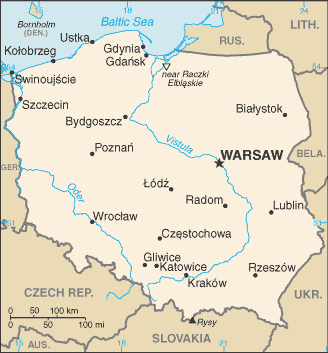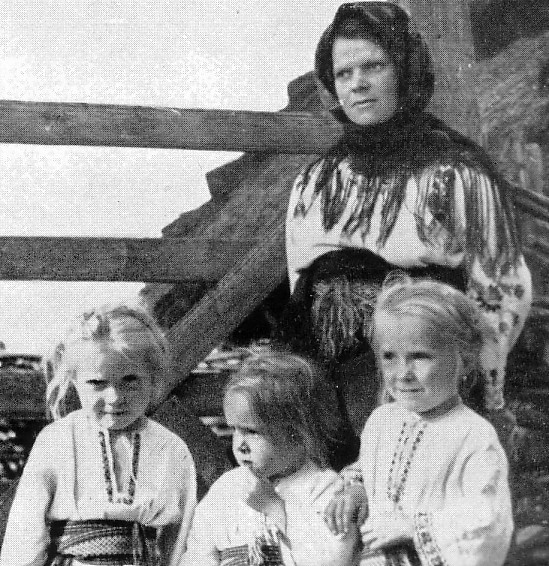Poland


Geography
Location: Central
Europe, east of Germany
Area: 312,685 sq km
Area comparative: slightly smaller than New Mexico
Climate: temperate with cold, cloudy, moderately severe winters with frequent
precipitation; mild summers with frequent showers and thundershowers
Terrain: mostly flat plain; mountains along southern border
Natural Resources: coal, sulfur, copper, natural gas, silver, lead, salt,
amber, arable land
People
Population: 38,635,144
Age Structure: 0-14 years: 16.7%
15-64 years: 70.3%
65 years and over:
13%
Median Age: 36.43 years
Population Growth Rate: 0.03%
Birth Rate: 10.78 births/1,000 population
Death Rate: 10.01 deaths/1,000 population
Sex Ratio: at birth: 1.06 male(s)/female
total population: 0.94 male(s)/female
Life Expectancy at Birth: total population: 74.74 years
male: 70.71 years
female: 79.03 years
Ethnic Groups: Polish 96.7%, German 0.4%, Belarusian 0.1%, Ukrainian 0.1%,
other and unspecified 2.7%
Religions: Roman Catholic 89.8% (about 75% practicing), Eastern Orthodox 1.3%,
Protestant 0.3%, other 0.3%, unspecified 8.3%
Language: Polish 97.8%, other and unspecified 2.2%
Literacy: definition: age 15 and over can read and write
total population:
99.8%
male: 99.8%
female: 99.7%
Economy
GDP (purchasing power
parity): $489.3 billion
GDP (official exchange rate): $249 billion
GDP - real growth rate: 3.3%
GDP - composition by sector: agriculture: 2.8%
industry: 31.7%
services: 65.5%
Labor Force: 17.1 million
Unemployment Rate: 18.3%
Population Below Poverty Level: 17%
Agriculture Products: potatoes, fruits, vegetables, wheat; poultry, eggs, pork,
dairy
Industries: machine building, iron and steel, coal mining, chemicals,
shipbuilding, food processing, glass, beverages, textiles
Slavs in Europe

Migrated
from Central Asia in 3rd or 2nd millenia BCE
East Slavs: Russians,
Ukrainians, and Belarussians
West Slavs:
Poles, Czechs, Slovaks, and Wends, or Sorbs
South Slavs:
Serbs, Croats, Slovenes, and Macedonians (Bulgarians, of mixed origin
like the Hungarians, speak a Slavic language)
Poland: Ethnic Origins
W. Slavic tribe
the polanie
pol means
“field” in Polish
reference to geography of Poland
Polish ethnic stock
Mixed with Germanic tribes from the W
E Slavs from the Russia, Belarus, Ukraine
Scandinavians (esp. Swedes) from the N
Peasant Culture
The Polish Peasant, Thomas and Znanecki

Characteristics of peasant
life
familial solidarity
absolute;
loyalty/assistance to family demanded by degree of relation
**husband/wife unit
marriage – not based on
love/sex/affection
rather RESPECT
their behaviors reflect
upon each other; do nothing that would lower the social standing of one
another’s families
e.g. shameful for wife to do hired
labor
dowry – received by the couple from both
sides
[still really the communal property of the
family because they are part of the family]
couple does not become individualized – a
new nucleus but forever tied to the larger family network
parental control/responsibility
LAND – SANCROSANCT
the means of family sustenance
father retires when son
becomes more able to manage the farm than he
patriarchy-boys more
important than girls – they get the land
pride = familial, not
individual
likewise
with shame
**collectivity/family group
identity
not indiv.
reinforced by village, community
Polish
Political History
1st United
State:
Mieszko I 966
converted to Christianity (Catholicism)
Founds the Piast Dynasty
Major
competitors, invaders
Teutonic Knights
Tatars
Wladyslaw I reunites in 1320
Kazimierz the Great 1333-1370

Jadwiga
marries Wladyslaw II Jagiello 1386
Jagiellonian Dynasty
Defeat the
Teutons at Battle of Tannenburg in 1410
16th Century
Commonwealth of Poland and Lithuania

Noble
Republic 1572-1795
Elected Monarchy

First
Republic/Constitution
May 3, 1791
The Second
Republic (1918-1939)
Interwar Period
General Pilsudski
WWII
Molotov-Rippentrop Pact
Invasion September 17,
1939

Occupation by Nazis
Eastern Front
Holocaust

Communist
Period 1945-1989

Solidarity
Movement
Strikes, Gdansk
Shipyards








Legacies of
Communism

Traditional
bases of National Identity
Catholicism, Marianism


Our Lady
of Czestochowa (The Black Madonna)
Poland as Christ in Europe
nationalism (anti-Germanic, anti-Russian)
land (the Fatherland)
the Polish family
Today
Post-Communist
trend toward nationalism/racism/anti-foreigner sentiments
Government
Government Type:
Republic
Capital: Warsaw (pictured below)

Legal System: mixture of Continental (Napoleonic) civil law and holdover
Communist legal theory; changes being gradually introduced as part of broader
democratization process; limited judicial review of legislative acts, but
rulings of the Constitutional Tribunal are final; court decisions can be
appealed to the European Court of Justice in Strasbourg
Dual Executive
President and Prime Minister each have executive powers
like French system, but president now weaker than French president
Power struggle Walesa and Sejms of
the early 1990s
New Constitution: PM/Sejm supreme with some powers and
checks for the president
Has power to sign treaties, control
armed forces, must sign bills into law
President directly elected; 5 year term; re-election possible
2 ballot election
The Executive Branch
Chief of State: Borislaw
Komorowski (PO)

Former Solidarity activist;
historian
Was Speaker of Sejm
Defeated Jaroslaw Kaczynksi (PiS) (Lech’s
twin) in second round of July 2010 elections
53.1% vs. 49.66%
President Lech KACZYNSKI (PiS) elected
in 2007 – killed in plane crash
going to Katyn Memorial Service in April 2010
Crash a second decapitation of Polish elites
Office of the President’s Website
Head of Government: Prime Minister Donald Tusk (PO)

Cabinet: Council of Ministers responsible to the prime minister and
the Sejm
The Legislative Branch
Bicameral legislature
consisting of
Upper House
The Senate (Senat)
100 seats
members are elected by a majority vote (first past the post) on a provincial
basis to serve four-year terms; seats per province vary from 2-4; elections held
simultaneously with Sejm
Lower House
The Sejm

460 seats
members are elected under a complex system of proportional representation to serve
four-year terms
5% threshold (except for German minority-guaranteed seat) and 8% threshold for
coalition
Factionalism, splintering very
typical
Left-Right Cleavage
Results
2007 Elections; Government Coalition between the PiS and PO
Law and Justice Party
right wing party
former AWS and ROP members
traditional, Euroskeptic, populist
social policies based on Catholic Church
anti-communist
pro "lustration" but
Economically, leftist
state-guaranteed minimum social
safety-net
intervention of the state into economic
issues
proposes two personal tax rates (18% and
32%)
tax rebates related to the number of
children in a family
reduction of the VAT rate
privatisation with the exclusion of
several dozen state companies
of strategic importance for the country
PiS opposes cutting social welfare
spending
proposes the introduction of a system of
state-guaranteed housing loan
Politically
for centralizing power - removing
governing bodies over media, monetary policy
giving president decree powers
pro-EU and keeping Polish forces in Iraq for one more year (since
election)
center-right; liberal-conservative,
i.e., conservative socially, liberal economically
coalition of post-Solidarity party (AWS)
Freedom Union (UW) (center liberal party)
Freedom Union (now defunct); 2005 became Democratic
Party (PD)
liberal party, centrist
merger of former Democratic Union and Liberal-Democratic
Congress;
individual liberty, centrist, pro EU integration
rapid privatization
former Foreign Minister and MEP Bronislaw Geremek
(d. 2008; killed in car
accident)
Part of the
ALDE parliamentary group in the EU
Democratic Left Alliance (SLD)
Post communist successor party
Professional,
pragmatic, social-democratic, pro-business, pro-NATO, pro-EU
The most
successful party in Poland till scandals under Leszek Miller’s
government
Former two-term president Aleksander Kwasniewski

Former PM Wlodimierz Cimosewicz
The Judicial Branch
Supreme Court (judges are appointed by the president on the recommendation of
the National Council of the Judiciary for an indefinite period)
Constitutional Tribunal (judges are chosen by the Sejm for nine-year terms)
